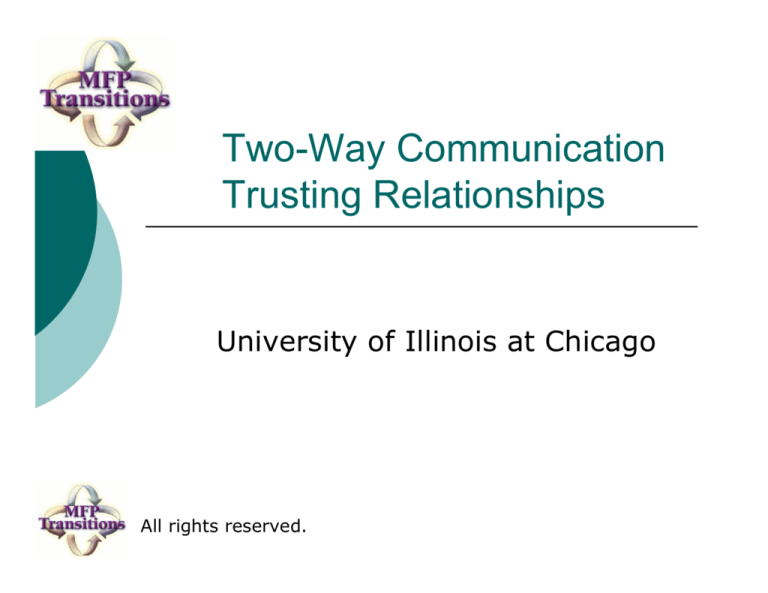
Two-Way Communication
Trusting Relationships
University of Illinois at Chicago
All rights reserved.
Purpose
{
Define communication – including:
Two-way communication
{ Verbal and nonverbal communication
{
{
{
Identify both positive and negative
communication techniques
Define a trusting relationship and
list techniques essential to
developing one
Objectives
{
Reader will develop knowledge of:
z
z
z
Definitions of both verbal and
nonverbal communication.
Importance of a trusting relationship
between TC and
participant/family/caregiver(s).
Communication techniques with
application to a case study.
Definition
Communication
1
“Any process in which a message containing
information is transferred, especially from one
person to another, via any of a number of
media. Communication may be verbal or
nonverbal; it may occur directly, such as in a
face-to-face conversation or with the
observation of a gesture; or it may occur
remotely, spanning space an time such as in
writing. Communication contributes to the
development of all therapeutic relationships”
(p. 426).
Communication
{
Two-way communication:
z
z
z
z
Information has to be SENT from one
person and RECEIVED by another person.
Meaning needs to be received and
translated to a level of understanding.
Roles can be reversed. The sender can
become the receiver and the receiver can
become the sender at any time in a
conversation.
Can be verbal and/or nonverbal
Definitions
{
Verbal Communication
z
z
{
Most common form
Involves talking and listening
Nonverbal Communication
z
z
z
z
Facial expression
Presence or absence of eye contact
Posture
Body movement
Reflection Question
{
{
One of the participants you are
working with repeatedly smiles and
blinks his eyes at you when you
make a visit to his home.
This is an example of what type of
communication?
z
z
Verbal
Nonverbal
Positive Communication
{
Positive communication is:
z
z
z
z
Open – react honestly, acknowledge
others thoughts and feelings, assume
responsibility for your own thoughts
and feelings
Empathy – experiencing the other’s
point of view without judgment
Supportive – nonthreatening,
nonjudgmental attitude
Equality – all participants are valuable
and should be heard
Trusting Relationship
{
{
{
A trusting relationship is essential to
good communication
Relationships need to be nutured.
Factors that enhance development
of a trusting relationship:
z
z
z
z
z
Protect one’s privacy
Keep promises
Avoid negative communication
Be available to listen
Treat with respect
Reflection Question
{
How might you develop a trusting
relationship with one of your
participants?
z
z
z
z
z
z
Be open
Be honest
Be supportive
Protect one’s privacy
Put yourself in his/her place
Always be respectful
Communication Techniques
{
“I” messages - Use messages that start
with “I” rather than “U”
z
z
{
Establish eye contact
z
z
{
Less likely to appear that you [sender] are
blaming the other person [receiver] for
something
Receiver is less likely to feel threatened by the
sender’s statement
Shows the full attention of the communicator
Participant likely to feel like someone is
listening to him/her
Clarify information
z
“I heard you say…is that correct?”
Communication Techniques
{
Keep promises
z
z
z
{
Shows honesty and integrity.
Once someone says “yes” to something
that person should make every effort to
follow through on it.
If individual is not able to follow through,
tell the other person why it is not
possible for you to keep your word.
Express empathy
z
The ability to mentally put oneself in the
place of another to better understand
and share feelings.
Communication Techniques
{
Use open communication
z
z
{
Be aware of body language
z
{
Use open-ended questions so that more than a
“yes” or “no” answer is given.
Example: Tell me how you feel about your first
doctor’s appointment tomorrow.
Have an open frame = arms by your side
versus arms crossed.
Using touch
z
A pat on the back or a touch on a shoulder is
okay, but be aware of participant’s personal
space.
Negative Communication
{
Be aware of and try to avoid
negative communication techniques
z
Blocking – general answers and
impersonal
{
z
False Assurances
{
z
“don’t worry” or “it will be okay”
Conflicting messages
{
z
“Everyone feels that way at times”
Conflicting verbal and nonverbal
messages
Rescuing or giving advice
{
“I think you should”
Reflection Questions
{
{
{
In thinking about participants that you
have worked with in the past, can you
recall…
An example of open communication?
An example of negative
communication?
A time when communication was
difficult and how did you handle it?
Active Listening
{
Sometimes the hardest thing to do is
nothing – just listen, wait, listen, clarify,
listen
z
z
z
z
Give your full attention
{ Move to a quieter spot, if needed
{ Clear up confusion
Pay attention to your body language
{ Stand or sit across from the person
speaking
{ Make direct eye contact
Note his/her nonverbal communication and
respond to it
Give participant an opportunity to think about
what he/she wants to say
Case Study
{
{
{
{
Joe is newly transitioned to an apartment.
He has a caregiver, Tim, that comes in
every morning to assist Joe with his a.m.
care.
Joe tells you [TC] that Tim has been jerking
his arms around during transfers to his
wheelchair.
Now, Joe is complaining of pain in his right
arm. He is scared to tell Tim that he is
hurting him.
What communication techniques could you
[TC] use when talking with Joe about this
situation?
Case Study
z
z
z
z
Open – acknowledge Joe’s concerns and
feelings; openly express your concerns with
Joe.
Supportive – do not judge Joe. Joe should feel
comfortable sharing this information with you
knowing that you will listen to him.
Empathy – put yourself in Joe’s place and
share feelings related to this situation
Equality – it is important to include all people
even the caregiver, Tim. Discuss with Tim
whether something is bothering him.
Case Study
{
You say to Joe.
z
I hear that you are concerned about
how Tim’s behavior has changed. I
believe it is important to look into why
this change has happened. Also, we
need to find out if you are physically
hurt. We should include Tim in
exploring this situation.
Comprehension Questions
{
{
{
{
Provide an example of positive and
negative nonverbal communication?
Provide an example of positive and
negative verbal communication.
Name a few key points that will help
you develop a trusting relationship
with a participant.
What can be gained through active
listening?
Examples of positive and negative
nonverbal communication
{
Positive nonverbal communication
z
z
z
{
Make direct eye contact
Keep an open frame = arms at your
side
Face the person you are speaking to
Negative nonverbal communication
z
z
z
Turning your back to the person speaking to you
Arms crossed over your chest
Frowning
Examples of positive and negative
verbal communication
{
{
Positive verbal communication
z
“I” statements
z
Empathy
z
Supportive
z
Not judging
Negative verbal communication
z
Blocking statements
z
False assurances
z
Giving advice or trying to rescue
Key points towards developing a
trusting relationship
{
{
{
{
Keep information private
Keep promises – if you promise to
get information, get it
Always be respectful
Be available to listen
What can be gained through active
listening?
{
{
Gives you time to observe
nonverbal communication
Gives the sender time to reflect on
their own thoughts
References
{
{
{
{
{
{
Cherry, B., Jacob, S. Contemporary Nursing. Issues,
Trends, & Management. Elsevier/Mosby St. Louis. 2005
Craven, R. & Hirnle, C. Fundamentals of Nursing
Human Health and Function. Lippincott Williams &
Wilkins. Philadelphia 2007.
Majerovitz, S. Deborah, Mollott, Richard J. and Rudder,
Cynthia(2009)'We're on the Same Side: Improving
Communication Between Nursing Home and Family',
Health Communication, 24:1,12- 20. URL:
http://dx.doi.org/10.1080/10410230802606950
Mosby’s Dictionary of Medicine, Nursing & Health
Professions. 7th ed. 2006.
Sellman, D. Trusting patients, trusting nurses. Nursing
Philosophy. 8, 2007. p. 28-36.
Tveiten, S. & Severinsson, E. Communication – a core
concept in client supervision by public health nurses.
Journal of Nursing Management. 2006. 14. p. 235.









